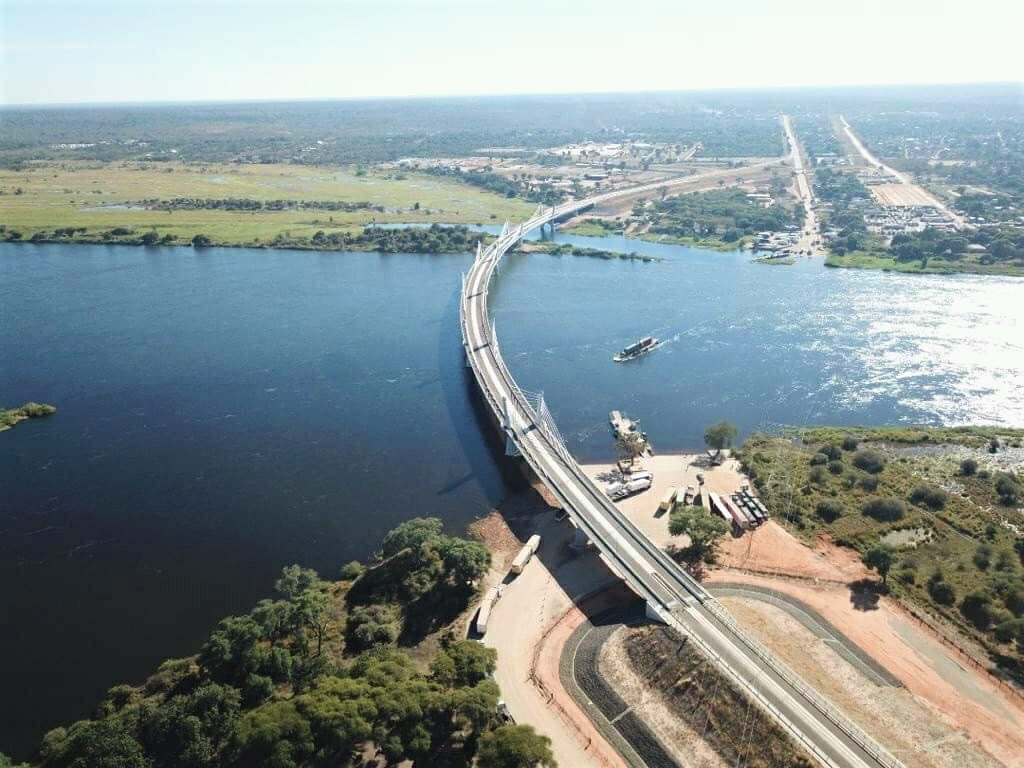The official opening of Kazungula Bridge have been a major talking point this week in Zimbabwe and Southern Africa at large. The bridge is set is to improve the efficiency of transit traffic and boost trade activities across Southern Africa.
In a presentation to the UN (OHRLLS), the Executive Chairman of Athari Group, Glory Jonga gives an in-depth review of the multinational project
The North-South Corridor (NSC) is a key trade route in Africa. It is approximately 2800km long stretching from the mining region of Lubumbashi in the Democratic Republic of the Congo (DRC) to the port city of Durban in South Africa. Along the way it passes though the Copperbelt (Zambia’s industrial heartland) and Gaborone, the capital of Botswana. With spill over effects, the corridor further integrates Namibia, Zimbabwe, Lesotho and Eswatini.
The NSC is primarily road-based and the Kazungula crossing point at the Zambezi River at a confluence between Zambia, Botswana, Zimbabwe and Namibia was a critical bottleneck that prevented the efficient flow of goods due to the lack of a bridge across the river (a ferry was being used instead).
The development of a Bridge at the crossing was an opportunity to increase the capacity and speed of transit and also introduce an alternative mobility mode: railway transportation.
The Kazungula Bridge Project (KBP) is a multi-national project on the NSC within the Southern African Development Community (SADC) region and part of a corridor-long infrastructure improvement programme. The project was identified as a key project under SADC’s regional development plan and was spearheaded by the governments of Botswana and Zambia.
The project scope includes a bridge linking Botswana and Zambia over the Zambezi River and juxtaposed one-stop border facilities at Kazungula.
The project’s development objective is to improve the efficiency of transit traffic through the Kazungula border to facilitate and increase trade activities and global competitiveness of Zambia and Botswana; improve regional connectivity of the NSC; and contribute to economic regional integration within the SADC region.
The project’s stated outcomes include: reduced border transit time; improved procedures on trade facilitation; improved border management operations, and consequently increased traffic throughput and reduced time-based transport and trade cost (African Development Fund (ADF), 2011).
The Bridge
• It is a 925m long, 18.5m wide viaduct across the Zambezi River
• Design type: extradose cable stayed bridge
• Longest span: 129m
• Number of road lanes: 2
• Railway tracks: 1, narrow gauge 1.067m
• US$260 million capital cost
• Main contractor Daewoo of South Korea
• One-stop border crossing facility located on the Zambian side
Financing the Project
The implementation of KBP was divided into three contract packages namely:
• Package one: bridge and approach Ramps;
• Package two: one stop border post (OSBP) facilities Botswana side and approach road; and
• Package three: one stop border Post (OSBP) facilities Zambia side and approach road.
The estimated total project cost is USD 259.3 million funded through a co-financing arrangement between the African Development Fund (ADF) and JICA. The Africa Development Bank (through ADF) covers 31.5% of the total project cost. The balance is shared between JICA (57.5%), Governments of Botswana and Zambia (9.2%) and EU-ITF Grant (1.8%) (ADF Project Appraisal, 2011). The project implementation period is five (5) years.
The loans from AfDB and JICA are zero interest, with a tenure period of 50 years inclusive of a 10 -year grace period (ADF, 2011). The executing agency for the project is a combination of the Zambian and Botswana road authorities.
Governance
The bridge will be managed by the Kazungula Bridge Authority, which will be set-up using the European Union Infrastructure Trust Fund (EU-ITF) grant. In effect, the project will be run similar to other trans-boundary projects such as the Zambezi River Authority, a body corporate enacted by parallel legislation in the Parliaments of Zambia and Zimbabwe.
Economic Sustainability
Evaluation of economic sustainability was based on the economic internal rate of return (EIRR) and the net present value (NPV) of toll revenue. With an assumed opportunity cost in Zambia of 12%, the base case of the project yielded an EIRR of 23% and a benefit cost ratio of 2.34. Even with an increase in costs of 20% and reduction in benefits of 20%, an EIRR of 17.5% and benefit-cost ratio of 1.56 provided a convincing case for financing the project (ADF, 2011). The cost of operating the bridge (OPEX) was intended to be covered by the toll revenue. A conservative assumption of 2.5% annual growth in traffic and 5% annual growth in OPEX were assumed and found to be covered by projected toll revenue (ADF, 2011).
Challenges
Boundary Dispute
A boundary dispute ensued among the partner countries. Botswana and Zambia had originally intended to work with Zimbabwe on the project. However, Zimbabwe later pulled out of the project as a result of some dispute at the time about the country’s boundary. Zambia and Botswana decided to go ahead with the project but Zimbabwe refused passage of the bridge through her territory. The Bridge, which was supposed to be 600 metres long, had to undergo design alterations and have its belly stretch away from Zimbabwe and curve into Zambia. The changes to the bridge design saw it stretching to 923 metres. However, according to President Masisi of Botswana speaking at the official launch of Kazungula Bridge, Zimbabwe has agreed in principle to be a partner in this project and the countries are now working on the legal framework.

